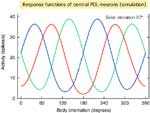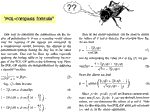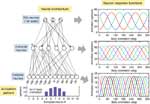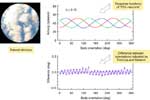
| A neural model for compass neurons | ||
| This project is in cooperation with Dimitrios Lambrinos (Artificial Intelligence Lab, Department of Computer Science, University of Zurich. As explained (see above), the cricket's POL1-neurons may represent the first processing layer of a "simultaneous" system of polarization vision, in which e-vector orientation is defined by the signals of three differently tuned polarization-sensitive input channels (Fig. 7). How does the nervous system extract e-vector orientation from the three POL-neuron signals? The procedures proposed so far did not take into account the constraints of actual neuronal circuits, i.e. they involved complex mathematical formulations without proposing any neural implementation (see Fig. 8). We designed a simple neural network that uses only well-known neuronal operations, i.e. synaptic excitation and inhibition, and a threshold function. The network consists of a number of layers with the activity being propagated through the layers in a feed-forward manner (see Fig. 9). The output-layer of the network consists of an array of narrowly-tuned "compass neurons" each representing a certain body orientation with respect to the zenithal e-vector. Each body orientation produces a characteristic activity pattern among the compass neurons with only a group of neurons active (Fig. 9, lower left). The activity pattern is independent of the degree of polarization. We used a system with 12 compass neurons representing the 180° range of the polarization compass. Body orientation was assumed to be coded by the activity-weighted average of the population of active neurons. We tested the network with polarization signals recorded with three opto-electronic model POL-neurons in natural skies, in which the polarization pattern was partly disturbed by clouds or trees (Fig. 10). We found that the performance of the network was almost identical to the performance of the mathematical algorithm used (Fig.8), i.e. the body orientations indicated by the two procedures differed by only a small fraction of a degree (Fig. 10 bottom). For more information see reference: Ongoing and future research We are presently testing and refining the network (Fig. 9). Eventually we will implement it in Sahabot 2, replacing the mathematical algorithm (Fig. 8) for evaluating the POL-OP signals. The orientation performace of the robot will then be tested in the field under a variety of sky conditions. In parallel to our modeling studies, we will try to confirm the actual existence of "compass neurons" in the cricket visual system by electro-physiological recordings (see project Insect POL-neurons / Cricket POL-neurons / POL-neurons in the central complex). |
|
more >> more >> more >> more |




